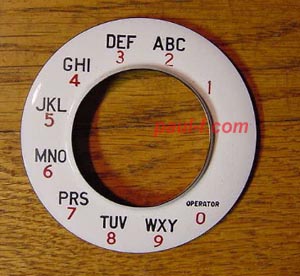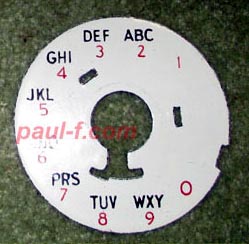|
|
|
|
|
|
| Number Plates on this
page: For #1 - #5 dials
Reference chart: 131, 132, 149 and
150-types 1933 All Plastic P-34016 for #6 dial 164-type "Universal" Northern Electric |
| This page summarizes information discussed in
several on-line forums, including the TCI listserv and
Classic Rotary Phones Forum. On the Forum topic,
you'll find member discussions and larger photos. To join the discussion, go here: http://www.telephonecollectors.org/list.htm http://www.classicrotaryphones.com/forum/index.php?topic=10624.0 The photos below are either original photos I have taken, are photos contributed by others with permission to post, or are edited from what are believed to be public domain sources. Please contact me to report any photos that need further permission or credit notices. Thanks to Greg Sargeant, poplar1, rdelius, LarryinMichigan and Steph Kerman for input and QA help. |
Number
plates
designed for the numbers 1 thru 5 dials were numbered with
the following model numbers and an added suffix, shown in
the table below. All suffix codes may not be available in
all models.
Suffix codes were
appended to the number plate model number, e.g. 132-B,
and were also appended to the dial's model number,
e.g. 4HE (4H dial with E number plate).
|
||||||||||||
| Suffix |
Description | Notes |
||||||||||
| A |
Includes numerals and not
letters. "Operator" around the 0 (zero). |
|||||||||||
| B |
Includes numerals and
letters. "Operator" in a horizontal line with the 0 (zero). |
Blauvelt's plan.* No letter Z on 131 and 132. |
||||||||||
| C |
Includes numerals and
letters. No text near the 0 (zero). |
Blauvelt's plan. | ||||||||||
| D |
Includes numerals and not
letters. "Long Distance" around the 0 (zero). |
|||||||||||
| E |
Includes numerals and 4
Party Line letters. "Operator" around the 0 (zero). |
Blauvelt's
Plan. 4-party service: J, M, R and W. |
||||||||||
| G |
Includes numerals and 9
letters. "Operator" around the 0 (zero). |
NOT Blauvelt's
layout. M, X, H, E, A, C, Y, U and J. Possibly represent office codes. ** |
||||||||||
| H |
Solid white |
used on paystations. | ||||||||||
| References:
Catalog
7, C18.005.00, issue 4, 2/63, C34.101, issue 3, 3/37, issue 6, 2/55 and issue 7, 12/56, C34.102, issue 3, 12/56. |
||||||||||||
| 131 - For Number 1 Dials |
132 - For Number 2 Dials |
149 - For Number 4 and 5
dials Fits Number 2 dials Celluloid over steel |
150 - For Number 4 and 5
dials Fits Number 2 dials Vitreous Enamel |
131A --
Numbers, Operator |
132A |
149A |
150A |
| 131B --
Numbers, Letters, Operator |
132B |
149B |
150B -
"Z" removed in 1953. |
131C --
No "Operator" text |
132C |
149C |
150C
(Is this WE or aftermarket?) |
131D --
Long Distance |
132D |
149D |
150D |
132E --
Party Line, JMRW |
149E |
150E |
|
132G --
MXHEACYUJ |
|||
| 132H -- All White (Coin Collector) | 149H |
150H Marked on either front or back |
|
132-type
Back Three locating pins |
149-type
Back |
150-type
Back |
|
Other found variations |
|||
D-53438 |
Cyrillic |
||
| An all plastic version has
also been found. It received two patents, but apparently did not achieve widespread use. |
|
1933 - Patent Pending - II-33  |
1934 - Patents 1,933,315 (1933) and 1,963,439 (1934) - IIII-34  |
| The plate was made from
three layers of cellulose acetate. The middle layer
was opaque, with the printed numerals and letters.
Transparent layers were fused above and below. The
patents claim the device overcomes objections of the
traditional number plates -- including cracking porcelain,
wear to the numerals and letters and entry of dust into
the dial. The patents were granted to George Cox and Charles Gutberlet of Philadelphia. Mr Cox was at one time affiliated with Williams & Marcus Co. The frim advertised itself as "Printers and Embossers, Envelope and Tag Manufacturers." He also holds patents covering number card design. See "Protecting the Humble Number Card" in the February 2014 Singing Wires. Even though it looks very similar to the Western Electric number plates and fits WE dials, this was designed outside the Bell System. We have found no evidence so far that it was ever used officially within the Bell System. (Western Electric would probably have marked the lower plate with the date code IV-34, not IIII-34.) |
| The P-340016 number plate
was designed for the number 6 dial, announced in 1952. The different shape center cutout accommodated a new mounting system that used a metal fixture affixed by three screws. A black dot provided a visual indication that the dial plate will only fit a #6 dial. Therefore, it also indicates the dial it is on is a #6 without having to open the phone to look at the marking on the back of the dial. The dot was normally hidden under a black metal fingerwheel, but was visible through a clear fingerwheel on a colored set. |
  Plates made before
mid-1953 had a "Z" over the word "Operator," as the 150B
above.
|
| References: C18.005.00,
issue 4, 2/63, C34.101, issue 6, 2/55. |
| 164-type "Universal" number
plates To reduce inventory, this was desinged to fit all dials from #2 to #6. Introduced about 1954. |
|
|
164A
 |
164B -
for Coin Collectors* |
164C -
for 5300-type phones in colors |
164D -
for Coin Collectors and consoles* |
| *
For applications see the BSPs, including C18.005.00, issue
4, 2/63. References: C18.005.00,
issue 4, 2/63, C34.101, issue 6, 2/55 and issue 7,
12/56.
|
|
| Northern Electric 164-type "Universal" number
plates Similar to the WE 164A, but with numerals in black. The word "Operator" is omitted on some, for use where there was no operator or in French speaking areas. |

 |
